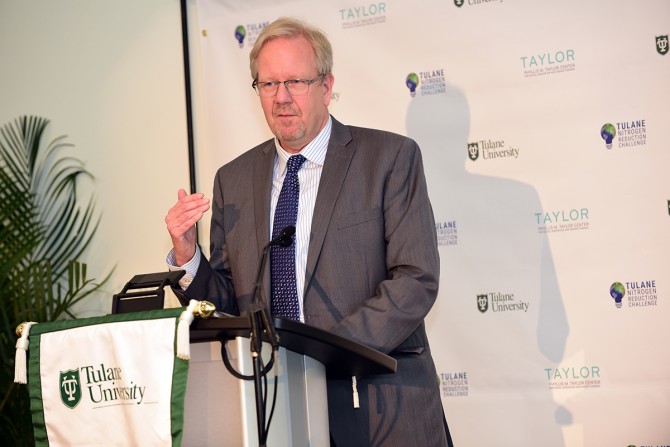Digital agriculture tech Adapt-N nets $1M Tulane prize
By Matt Hayes
Adapt-N, a team from Cornell, was awarded the $1 million grand prize from the Tulane Nitrogen Reduction Challenge Dec. 14 in New Orleans.
The international Tulane University competition seeks to find solutions to reduce nitrogen runoff from farming. Excess nitrogen application from agriculture spills into waterways and can lead to vast algal blooms in basins like the Gulf of Mexico. These blooms deplete oxygen in the water, a condition known as hypoxia, and cause mass die-offs of fish and wildlife. This worldwide problem is endemic to the Louisiana coast where the Mississippi River spills into the Gulf. The dead zone there is now approaching 9,000 square miles, and impacts the ecology of the area as well as important fishing and tourism industries.
The Adapt-N team developed a cloud-based computer modeling solution to predict optimum nitrogen application rates for crops. Adapt-N was selected from 77 registrants from 10 countries and competed against three other challenge finalists. Teams tested their innovations during the 2017 growing season on a farm in Northeast Louisiana along the Mississippi River.
A 16-member advisory board of academics, scientists, environmentalists, entrepreneurs, farmers and national experts selected the winner based on crop yield, nitrogen reduction, and the cost and market viability of their innovation.
Developed at the College of Agriculture and Life Sciences and now licensed to Yara International, Adapt-N gives farmers precise nitrogen recommendations for every section of their fields. The tool relies on U.S. Department of Agriculture soil databases, field-specific soil and management information, and high-resolution weather data from the Northeast Regional Climate Center at Cornell.
The software simulates how nitrogen is taken up by a crop and incorporates multiple factors, including risk and economic goals, to provide users with the optimal nitrogen application rate, according to Harold van Es, Adapt-N team leader and professor of soil science in the School of Integrative Plant Science. He teamed with Jeff Melkonian, senior research associate in SIPS, and Art DeGaetano, professor of earth and atmospheric sciences, to develop the tool.
“The key idea is that we precisely match the nitrogen with the crop needs,” van Es said. “We’ve been able to demonstrate that you can reduce the overall nitrogen rate while increasing profitability, so it’s really a win-win opportunity.”
The user enters basic information on management practices, such as the date of planting, the crop and hybrid type, the organic matter content in the soil, and tillage practices, according to van Es. “We combine that with other data, notably detailed soil data and weather records, like precipitation, solar radiation and temperature, and then we dynamically simulate the nitrogen environment in the field – in the soil and in the crop.”
The system is designed to enable farmers to monitor their fields and reduce the overall nitrogen rates while increasing profitability. The tool harnesses powerful data analytics and rapid communication available in the emerging realm of digital agriculture to help farmers manage resources while being better stewards of the environment.
“We can roughly reduce the environmental impact by about a third – 35 to 40 percent – and that’s both the impacts from nitrate leaching, which is the primary concern with the Gulf hypoxia issue, as well as greenhouse gas losses, which is also a big concern,” van Es said. Adapt-N can also be a central element to the use of other sustainable farming practices like cover cropping and nitrogen fertilizer stabilizers.
Tulane launched the grand challenge in 2014 to identify and nurture the most innovative and adaptable technologies to fight hypoxia. Phyllis Taylor, president of the Patrick F. Taylor Foundation and a member of the Tulane board of trustees, funded the effort.
Van Es remarked at the award event that the challenge highlights the opportunities with technological innovations: “But we should see this event in a much bigger context, in my view, as a start-off point for governments, the scientific community, the fertilizer industry and farmers to raise the bar on nutrient management. That will ultimately help solve the hypoxia problem. It is time. And I hope that they will fully embrace these types of innovations and help farmers overcome the adoption barriers.”
Matt Hayes is managing editor and social media officer for the College of Agriculture and Life Sciences
Media Contact
Get Cornell news delivered right to your inbox.
Subscribe